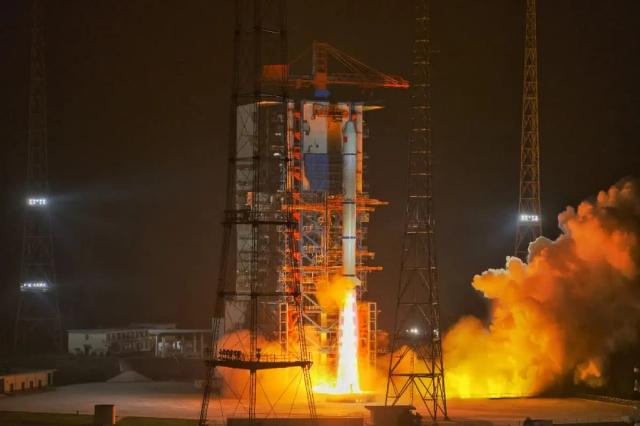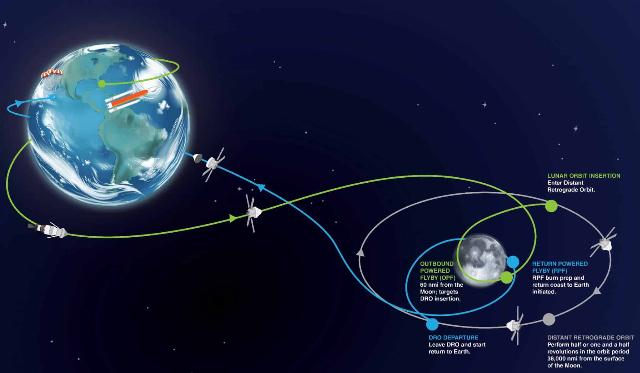In mid-March 2024, the launch of two Chinese satellites turned into a failure. The upper stage could not provide the correct trajectory, and the payload did not reach the target orbit. The mission was officially recognized as an emergency, but no details about its goals and the course of the flight were reported. New data from the American space intelligence showed that the vehicles were definitely not lost: they made a maneuver to change the orbit.
The SpaceNews portal reported that, according to the 18th Space Defense Squadron (18 SDS) The object with the international identifier 2024-048A at least once changed the altitude of its orbit from 525 x 132,577 kilometers to 971 x 225,193 kilometers between March 14 and 26. This object is associated with the launch of the Changzheng-2C launch vehicle on March 13 and, by all indications, is either an upper stage (third stage), or its payload mounted on an adapter, or one of two DRO-A and B satellites acting as a payload.
By all indications, China is making attempts to fulfill at least some of the tasks assigned to the unsuccessful mission to the Moon. However, the Celestial Empire did not provide any details about these maneuvers, and there were at least two maneuvers, because the object raised not only the apogee, but also the perigee of its orbit.
It is important to note that, as is often the case with Chinese cosmonautics, the objectives, capabilities and technical characteristics of the DRO-A and B spacecraft are not reliably known. There are only indirect signs by which American space intelligence experts can draw general conclusions.
The launch parameters of the Changzheng-2C (CZ-2C) carrier on March 13 are similar to the launch to the Moon. At least, China declared zones of closed airspace (regions of fall of spent first and second stages), characteristic for launching either to a geostationary orbit or on a departure trajectory to the Moon. A few hours after the launch, the Xinhua News Agency, the official state media of the Government of the People's Republic of China, published a short note about the failure of the mission ( Chinese, English ). It said that the Yuanzheng-1S (YZ-1S) upper stage could not accurately launch the DRO-A and DRO-B satellites into the target orbit. At the same time, it was noted: "work on recycling will begin in the near future."

Launch of the Changzheng-2C launch vehicle
Image source: OurSpace
The phrase about disposal is difficult to interpret otherwise than as reducing the payload from orbit to the dense layers of the Earth's atmosphere or transferring it to a burial orbit. Judging by the 18 SDS data, the tracked object is definitely not going to return home and, on the contrary, is moving away from Earth. If 2024-048A is both satellites side by side, and they have enough energy to raise their apogee by almost 100 thousand kilometers, then this looks a little like a burial maneuver.
There is very little left for the transition to a distant retrograde lunar orbit (DRO). It is difficult to calculate the exact perigee from which this is possible for 2024-048A, but it is located in the region of 320 thousand kilometers from Earth. To raise its orbit to this altitude from 225 thousand kilometers, much less fuel is needed than was required for the previous maneuver. Apparently, Chinese space engineers decided to try to get the most out of the satellites and test them at the maximum achievable distance under the current conditions.
What the task of DRO-A and B is can only be judged by the publication that has already disappeared from open access in the Chinese edition of the Journal of Deep Space Exploration ( archived copy ). In the article, scientists proposed to test the navigation system in lunar space using three satellites: one in low Earth orbit and two in far retrograde lunar orbit. The English-language abbreviation of this orbit (DRO) in the name of the satellites speaks for itself, and the first unit of the grouping (DRO-L) was launched in February 2024.
The unsuccessful results of the experiment with navigation in the circumlunar space should not negatively affect the current Chinese program for the study and exploration of the Moon. This is rather a side project, which, if successful, allows you to expand the possibilities somewhat.
Just a week after the launch of DRO-A and B, China sent the Qiuqiao-2 spacecraft, a repeater satellite and a radio telescope, into flight to operate in a highly elliptical lunar orbit. It will broadcast the signals of a soil sampling mission on the far side of the Moon, which is scheduled later in 2024. In addition, the Qiuqiao-2 carries several scientific instruments on board. So far, the mission is going completely according to plan.

